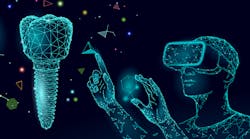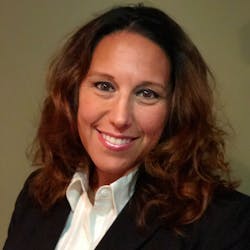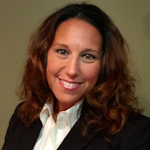Over the course of recent times, dental education has progressed tremendously. Advanced teaching and learning methods have been developed and refined. Today, these methods aid greatly in the understanding of the etiology, diagnosis, and treatment of human diseases and conditions. However, there remains a lack of an efficient and comprehensive methodology for providing proper patient care—i.e., having a way to understand human anatomy in depth before treating live patients in a dental or dental hygiene educational setting.
Enhancing tactile perception and assessment in dental education could greatly improve existing methods. Virtual reality (VR), which is broadly used and is fundamental in fields such as aviation and telecommunication, is now emerging as a viable training tool in health-care professions—and dentistry stands to benefit. This article will explore the interrelationship between VR simulation and current pedagogical knowledge. It will also provide an overview of the potential use of VR in dental education.
Traditional methods vs. VR
Traditional teaching and learning methods may not be suitable for today's technologically advanced world, as students often rely solely on their tablets and laptops for their educational resources and academic success. The internet has become a valuable supplement to education, allowing traditional lectures to become interactive, collaborative, and more visually based. The potential advantages of VR for dental education are frequently discussed as a means to improve fine motor skills and hand-eye coordination within clinical settings. VR could also surmount the financial and creative challenges that are often involved with dentistry's complex training.
Virtual growth in medicine
According to a report by Global Industry Analysts, virtual technology in the medical profession is anticipated to grow to $3.8 billion by 2020.1 Another report by Grand View Research concludes that the virtual technology industry will grow to $5.1 billion by 2025.1 Given this expansion, technology will further transform the health-care industry. Applications will range from training future and current health-care professionals to diagnosing and treating various conditions. With its capability to provide complete, immersive 3-D virtual simulations to clinicians, VR continues to be perceived as an effective diagnostic and salutary tool. Its applications have grown, and there is further potential for its use in addressing anxiety, autism, PTSD, desolation, pain management (particularly severe pain in burn casualties), and other conditions.2
Virtual education
The implementation of virtual technology into training health professionals is changing the future of education . VR provides virtual hands-on experiences for clinicians, who benefit by reducing harm to live patients and learning efficiently (such as retaining teachings better in their long-term memories). By connecting an array of distinctive technologies—an oculus headset containing a head-tracking system, headphones, guidance with exploration devices, etc.—virtual reality technology provides a multisensory and three-dimensional environment that helps users become completely immersed in an artificial environment.3
Virtual simulators have now become the norm in the fields of aerospace and aviation. VR medical applications such as neurosurgery, cardiovascular procedures, laparoscopy, vascular procedures, and certain biopsies, are currently in use. VR offers realistic, safe practices while providing feedback to the practitioner.2 Aside from creating realistic renditions of anatomical structures, simulators re-create all of the tactile sensations experienced during procedures. They provide accessories to supplement instruments for grasping and palpating tissues so that clinicians can truly feel while performing the procedures.4
In a best-evidence medical education (BEME) systematic review, researchers studied the capabilities of simulation technology in educational science. The study revealed that high-fidelity medical simulations were sufficient complements to medical academics in a patient care settings and facilitated trainee learning.5 The study emphasized the importance of emulating real-life, regulated educational experiences in which learners were active participants in the process.
Curriculum amendments are being directed by worldwide integration and global standardization, including new and advanced technologies such as oculus virtual simulation systems that provide unique capabilities for clinical training in medical academia.6
Improving outcomes
An ongoing study by Johns Hopkins University estimated that more than 250,000 people in the US may perish yearly from medical failures, which would make it the third-leading cause of death after heart disease and cancer.7The study, first released in 2016, investigated eight consecutive years of data for death rates. Analysts found that based on a total of 35,416,020 hospitalizations, there was a combined occurrence rate of 251,454 deaths annually derived from medical flaws. Two years later, in 2018, the numbers remained similar.7
The study outlined deaths due to medical error that were caused by an insufficiently trained staff, errors in judgment or care, and system defects. This included computer malfunctions, botched medication types or doses administered to patients, and possible surgical complications that may have been undiagnosed.7 These findings and others open the door for exploration of how VR can reduce unnecessary outcomes in health-care through better training, diagnosis, and health-care work itself.
Summary
Virtual instructional programs can personalize learning to individual needs and requirements and provide prompt feedback and support once problem areas are identified. Technology-based simulation software programs can improve education and clinical skills, as well as minimize potential harm to live patients while simultaneously providing individualized virtual learning.
Herbert Spencer, an English philosopher in the 1800s, stated, “The great aim of education is not knowledge but action.”8 The action Spencer argues for is that students, the academic environment, and the instructor’s influence will catalyze change. As such, it is the fundamental objective of adept education for students to become life-learners and doers. As we are seeing today, VR has the potential to further this objective.
References
- Virtual reality in healthcare. Global Industry Analysts, Inc. https://www.strategyr.com/market-report-virtual-reality-vr-in-healthcare-forecasts-global-industry-analysts-inc.asp
- Abdulmohsen A. Simulation-based medical teaching and learning. J Fam Community Med. 2010;17(1):35-40.
- Li L, Yu F, Shi D, et. al. Application of virtual reality technology in clinical medicine. Am J Transl Res. 2017;9(9):3867-3880.
- Ottensmeyer M, Ben-Ur E, Salisbury J. Input and output for surgical simulation: Devices to measure tissue properties in vivo and a hepatic interface for laparoscopy simulators. Stud Health Technol Inform. 2007;70:236-242.
- Issenberg S, Mcgaghie W, Petrusa E, Gordon D, Scalese R. Features and uses of high-fidelity medical simulations that lead to effective learning: A BEME systematic review. Med Teach. 2005;27(1):10–28. doi:10.1080/01421590500046924
- Perry S, Burrow M, Leung W, Bridges S. Simulation and curriculum design: A global survey in dental education. Aust Dent J. 2017;62(4):453-463. doi:10.1111/adj/12522
- Study suggests medical errors now third leading cause of death in the US. Johns Hopkins Medicine. May 3, 2016. https://www.hopkinsmedicine.org/news/media/releases/study_suggests_medical_errors_now_third_leading_cause_of_death_in_the_us
- Tomlinson S. From Rousseau to evolutionism: Herbert Spencer on the science for education. Hist Educ. 1996;25(3):235-254. doi:10.1080/0046760960250303
Related reading








